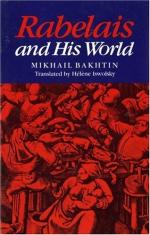
|
| Name: _________________________ | Period: ___________________ |
This quiz consists of 5 multiple choice and 5 short answer questions through Chapter 15, Chapter 6 - Images of the Material Bodily Lower Stratum.
Multiple Choice Questions
1. In which twentieth-century movement was the grotesque especially evident?
(a) Impressionism.
(b) Expressionism.
(c) Modernism.
(d) Futurism.
2. "Fat William," of comic folklore, symbolized:
(a) The entire body of the people.
(b) The health risks of obesity.
(c) Catholicism's huge influence in Europe.
(d) Bread and wine in bodily form.
3. How does the prologue of _Pantagruel_ demonstrate the connection between literature and the marketplace?
(a) It exhorts its readers to record in writing their own experiences of fairs and of Carnival.
(b) It offers a pricey alternative to illiteracy.
(c) It simultaneously advertises itself and praises the public.
(d) It begins with a detailed description of the author's hometown marketplace.
4. Bakhtin finds food and drink representative of society because:
(a) Certain societies eat only certain foods.
(b) The type of food or drink determines the type of person.
(c) Feasts were the only time available for socialization.
(d) The work of collecting and preparing meals was a community affair.
5. Why does Bakhtin consider oaths, curses, and profanities elements of freedom?
(a) Populist uprisings often have profanities and oaths in their declarations.
(b) A person can form any sound into a curse or profanity.
(c) Slaves are prohibited from using such forms of speech.
(d) They are contrary to official modes of speech.
Short Answer Questions
1. Which aspect of Renaissance culture does Bakhtin stress is still apparent in Western society today?
2. Bakhtin thinks that life is:
3. How are abusive and praiseful words reflective of grotesque realism?
4. During the "feast of fools" and the "feast of the ass," laughter:
5. According to Bakhtin's semiotic understanding, what irony is inherent within the creative power of language?
|
This section contains 397 words (approx. 2 pages at 300 words per page) |

|




